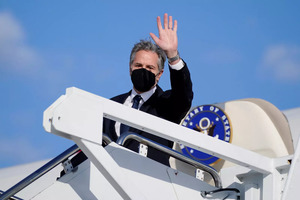
The West and Russia are pushing their own strategic narratives with tactics reminiscent of the Cold War era.
As tensions soar over Ukraine between Russia and the West, so does the information war between the two sides, each pushing their own strategic narratives and accusing the other of spreading disinformation and propaganda.
Russia has been positioning troops near the Ukrainian border since December, dispatching some to neighbouring ally Belarus. US weapons have been arriving in Kiev, while some NATO countries have dispatched fighter jets to Eastern Europe and put troops on standby.
Parallel to these developments, the US state department published a ‘fact sheet’ aiming to expose a “set of false narratives” the Russian government uses to further its policy goals – including Russia portraying itself as the victim rather than the aggressor.
The Kremlin has, in turn, pushed back against those claims. It has repeatedly denied it intends to invade Ukraine, but also called out western governments for spreading disinformation. A UK Foreign Office report accuses Russia of planning to install a puppet government in Ukraine. Kremlin denied the charge, branding it as “nonsense”. The rebuttal came with little detail, however.
“If Russia wanted to invade Ukraine, it would do it quietly,” argued Larissa Doroshenko, a political communication scholar at Northeastern University. “What we’re seeing right now is hysteria, a full-blown PR campaign,” she added.
Targeting English speakers on social media
A report published in January by the Ukraine-based Mythos Labs found that Twitter activity related to Ukraine and Russia intensified considerably in December and early January compared to November 2021.
The study detects an increase in the number of Ukraine-related tweets containing what it calls “pro-Russian disinformation and propaganda” by 375 percent compared to November, and by 3,270 percent compared to September. Using an AI-based software, it also found a spike in the number of accounts spreading such information – 697 between the start of December and the start of January compared to 58 in November.
The report casts its net wide when it comes to the identification of those accounts, which include well-known western journalists with a critical stance on NATO and western military intervention – such as Australian documentarist John Pilger and American investigative journalist Glenn Greenwald.
An increase in activity is hardly surprising given that Ukraine, where a war has been ongoing since 2014, has been making headlines in recent weeks. The conflict between Russia-backed separatists and the Ukrainian government in the eastern region of the country known as Donbass has killed an estimated 14,000 people since it began, cutting off entire villages from basic services and dividing families. But it fell largely off the media radar since the 2015 Minsk agreements, despite repeated ceasefire violations.
The report finds that increasingly, the messaging is directed to an English-speaking audience, with the number of English-language tweets posted shooting up over the months analysed – from 34 percent of the tweets related to Ukraine and Russia in November to nearly 60 percent in December. It found evidence that many were automatically reposted.
The analysis argues the Kremlin’s strategy has shifted “from amplifying inauthentic accounts to amplifying legitimate actors who voice pro-Kremlin talking points.” John Pilger’s tweets, for instance, were re-tweeted by 87 accounts identified as spreading pro-Russian disinformation and propaganda, while tweets by US congressman Matt Gaetz opposed to US intervention were retweeted by 12 such accounts – blurring the lines and making it look “less obviously disinformation.”
“Cold War” information tactics
“What we've seen is that it's not necessarily that Russia tries to present some fake information, although we have also seen evidence of that,” said Larissa Doroshenko, who studied Russian tactics at the time of the invasion of Crimea in 2014 and during the 2016 US Presidential elections, when thousands of Democratic Party emails were leaked, severely damaging Hillary Clinton’s campaign.
Rather, she argues, it is “engaging in this decades-old tactic of reflexive control, which was used during the Cold War. This is a tactic that presents information to the adversary in a way that leads this adversary to make a wrong decision.”
The idea behind it is, in other words, making your opponent voluntarily take decisions that actually favour their enemy’s strategy by studying their decision-making processes.
“But another [side] of this technique is to create distraction or dismay to exacerbate the situation,” she argues. “We’ve seen it in Ukraine in 2014, we’ve seen it in the US in 2016, and we also observe it now.”
Social media is bold.
Social media is young.
Social media raises questions.
Social media is not satisfied with an answer.
Social media looks at the big picture.
Social media is interested in every detail.
social media is curious.
Social media is free.
Social media is irreplaceable.
But never irrelevant.
Social media is you.
(With input from news agency language)
If you like this story, share it with a friend!
We are a non-profit organization. Help us financially to keep our journalism free from government and corporate pressure














0 Comments